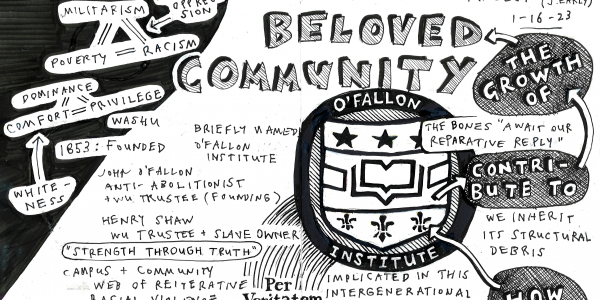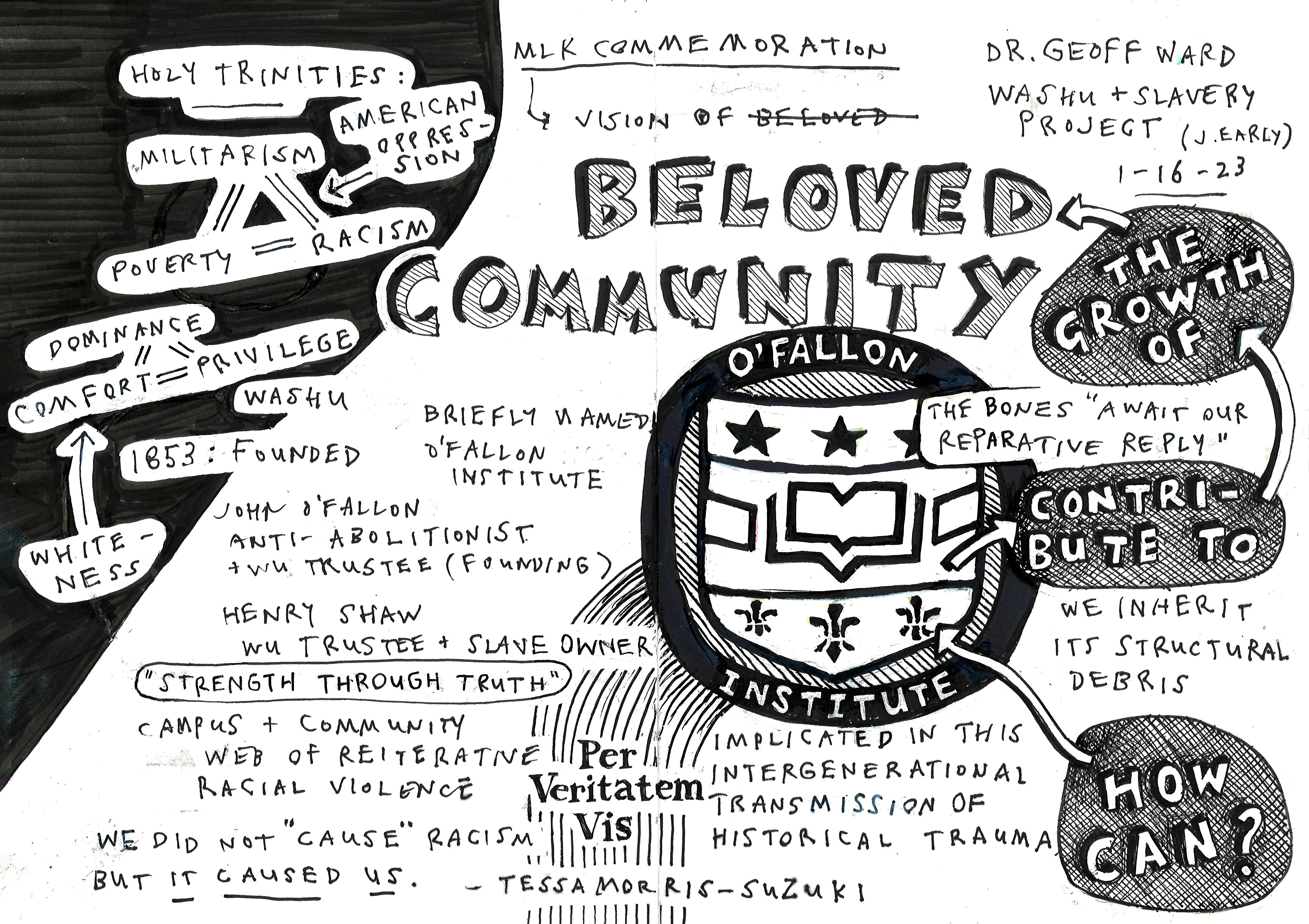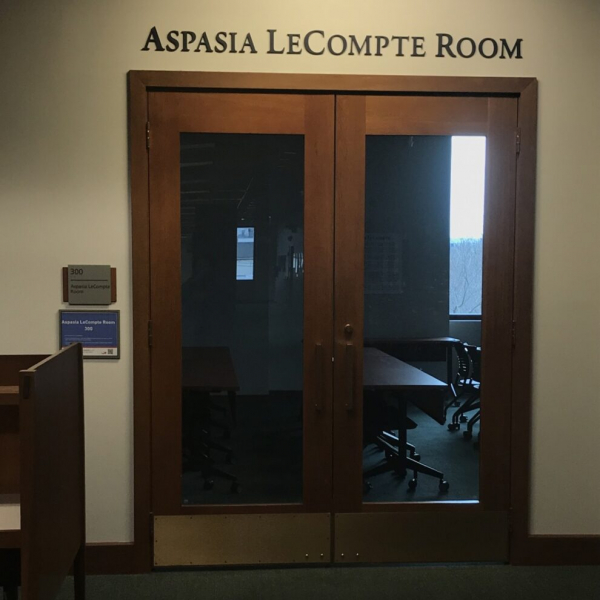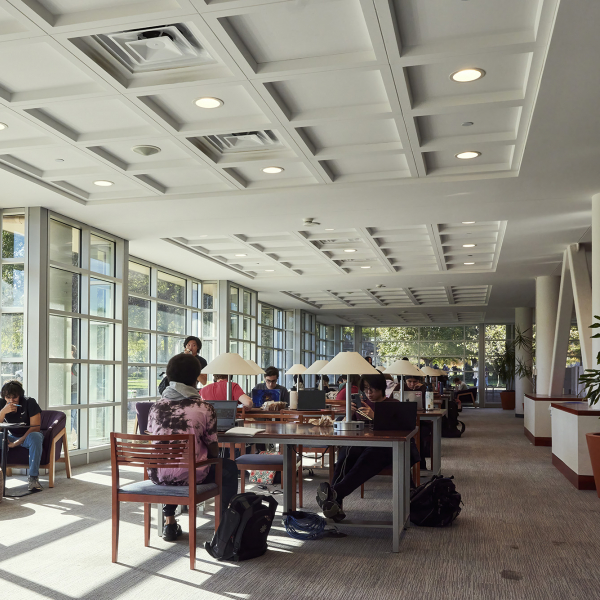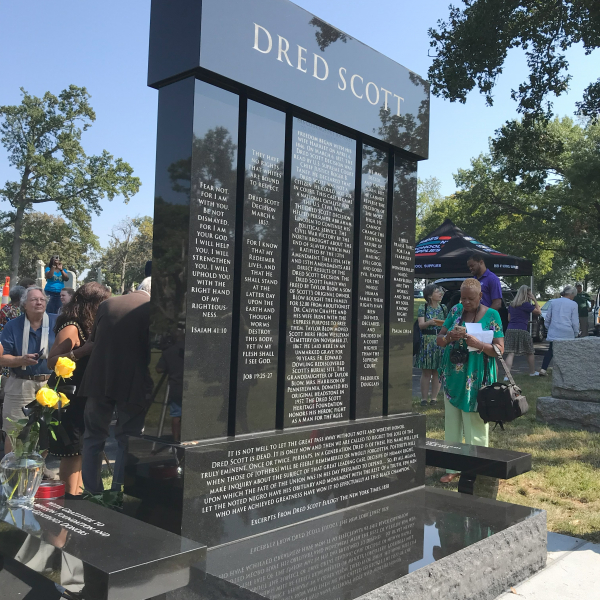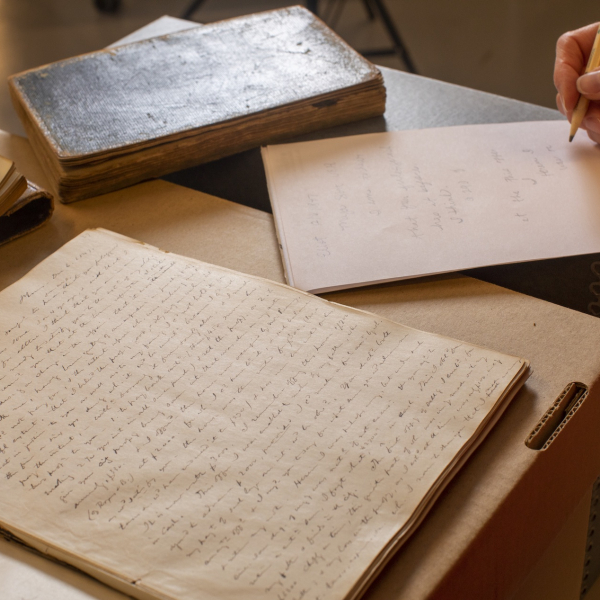In this keynote address at the 36th Annual Dr. Martin Luther King Jr. Commemoration at Washington University, the theme of which was Dr. King's concept of the "Beloved Community," WashU & Slavery Project director Geoff Ward urges our university community to acknowledge and confront its role in the under-realization of Dr. King's imagined "Beloved Community," and argues that by doing so we can contribute to a reconstruction of St. Louis as the "Beloved Heart of America."
Note: A video/audio version of this address can be accessed via a link below.
As I began reflecting on Dr. King’s vision of Beloved Community, I kept thinking about NBA coach Doc Rivers’ statement after the 2020 police shooting of Jacob Blake by police in Kenosha, Wisconsin. “We keep loving this country,” he said, tearfully, “and this country does not love us back.” Like so many African Americans, Dr. King in his lifetime and in death has given much to this nation yet gotten so little in return. I am not referring here to material returns. I am talking about true love and respect, a cultural-valuational embrace that would be evident in a fuller commitment to and realization of his often selectively and even cynically celebrated vision. This is the 36th Annual Commemoration of Dr. King at Washington University, and there are few signs our nation nears “an end to the chain of violence” and realization of “a community where [people] can live together without fear.” Dr. King believed nonviolent struggle would overthrow the terrible trinity of poverty, racism, and militarism, delivering a society organized by “mutual understanding and redeeming goodwill for all.” This, of course, has not come to pass, not even close.
Today I will share some of the ways our university contributed to this under-realization of a Beloved Community, which are becoming clear through the research of the WashU & Slavery Project. Like our peer institutions, WashU is implicated in the institutionalization of racism, and its distortion of the moral universe, and thus bears responsibility for advancing what Dr. King called a "a qualitative change in our souls as well as a quantitative change in our lives." Like others before us, I am also optimistic that St. Louis is poised to play a key role in advancing this change in our region, nation, and world. Our university can contribute meaningfully to reparative efforts already underway, a reckoning which might finally reconstruct St. Louis as America’s Beloved Heart.
WashU & Slavery
We are in just the second year of the WashU & Slavery Project, an initiative through the global consortium of Universities Studying Slavery, where members commit to examining and addressing the ways their institutional histories are bound up with the history and legacy of slavery. We are still in an early stage of discovery, and there is much still to learn about our 170- year history. As time will not permit an overview of all that we have uncovered, I invite you to visit our project site and read our initial progress report for more on what we are learning. I also want to recognize the contributions of our students, project fellow Dr. Kelly Schmidt, and several faculty and staff to insights and advances to date.
Our university was chartered in 1853, by the former Kentucky enslaver, prominent St. Louis merchant, and Missouri state senator Wayman Crow. WashU’s founding occurred amidst intense effort to protect the institution of slavery from a rising tide of abolition. That anti-abolitionist effort was led locally by one of our founding trustees and primary benefactors, John O’Fallon, who was among the wealthiest men and largest slave holders in the state at that time and so central to our foundation that the new university was briefly named O’Fallon Institute. Nearly two decades before our founding, O’Fallon reportedly led the Grand Jury that declined to indict anyone for the 1836 lynching of Francis McIntosh, under the direction of an appropriately named Judge Luke Lawless, who instructed the jury that an indictment would embolden abolitionists. One of WashU’s earliest buildings, the O’Fallon Polytechnic Institute, was later built at the very intersection where McIntosh had been burned alive by a white mob that enjoyed impunity. That building is where our School of Law began, and later became part of the separate and unequal St. Louis Public School system.
A decade after the McIntosh lynching, in 1846, John O’Fallon was named president of St. Louis’ Anti-Abolition Society in a meeting at the Old Courthouse – in the same year Dred and Harriett Scott initiated their freedom suit there. Under O’Fallon’s leadership, the Anti-abolition Society successfully lobbied the state to prohibit the education of African Americans in Missouri and take other measures that might derail the struggle for freedom. The following year, only six years before our university was chartered by this same body, the Missouri General Assembly passed legislation declaring that “no person shall keep or teach any school for the instruction of [African Americans] … in this state.” WashU was only a few years into its history when the Scott v. Sanford case finally reached the US Supreme Court, and its chief justice infamously held that African Americans were not in fact citizens, and therefore had “no rights a white man was bound to respect.” This is the environment, the corrupted democratic culture, our higher education institution emerges in.
Our early institutional history not only reflected dominant values of the day but refracted them into the future of St. Louis and larger world. There are more obvious examples of this, confined to our campus, such as denials of employment, educational and professional opportunities for most of our first 100 years. Yet our research has led us off campus, as well, because WashU’s entanglements with slavery and its wake involve numerous ties to adjacent and often closely coupled institutions and endeavors.
For example, research into the enslaver and WashU trustee Henry Shaw, the founder of the Shaw School of Botany which facilitated early and ongoing advances in plant science, introduced us to the botanist George Engelmann and his son, a WashU student, both of whom were ardent defenders of slavery, white supremacism, and the Confederacy. This led us to the records of the Academy of Science of St. Louis, founded by Engelmann, whose leadership included several enslavers, WashU faculty and administrators, and whose proceedings contributed to the local and global propagation of scientific racism. An 1898 meeting of the academy, presided over by a WashU alum who was then Dean of our School of Engineering and academy president, featured a pseudo-scientific presentation on “the Sociology of the Negro,” whose thesis was that Black people were savages, forever grateful for and dependent upon the civilizing influences of white men.
James Lucas, John O’Fallon, and other members of St. Louis’ slaveholding elite were also instrumental in the development of St. Louis’ medical schools. Prior to WashU’s establishment, and along with future WashU leaders including Eliot and James Yeatman, they funded and led the city’s first medical colleges, which combined in 1891 to form our School of Medicine. Typical of early American medicine, our medical schools and hospitals both denied equal access to advances in medicine and exploited African Americans in medical research. Skeletal remnants of this nonconsensual research remain part of our university collection, an example of the “structural inheritance” awaiting reparative reply.
The enslaver James Lucas also founded WashU School of Law, which I have noted took root at a site in St. Louis marked by racial terror lynching and unequal protection in law. Notably, several Black students graduated from WashU in the 1880s and 90’s; these are the only three known Black graduates in our first 90 years, and they were graduates of our law school. We have not yet found much about why African Americans were entirely excluded from the student body by the late 1890s, but one account is that it accommodated white student protests that Black presence was degrading to their own status and that of the university. By 1903, the year of the first issue of our university yearbook, The Hatchet, it is clear from the racist caricatures in this official document – including its advertisement section – that normative anti-Blackness and the marketing of white supremacy had firmly set in. Reiterating unequal protection, and echoing the Dred Scott decision fifty years earlier, one of these 1903 yearbook entries was created by our law students – a racist Moot Court skit mocking Black St. Louisan’s claims to civil rights.
The history of the arts at WashU is also illustrative of this campus and community web of reiterative racial violence, and recalls Saidiya Hartman’s insight that “the afterlife of slavery is not only a political and social problem, but an aesthetic one as well.” The St. Louis School and Museum of Fine Arts was established in 1879 through a gift of Wayman Crow, who extolled liberal notions of arts education in an enlightened democratic culture. Yet these visions were again circumscribed by white supremacy, with lasting implications for our art collection, and our historic role in the institutionalization of racism, and under-development of democratic culture through arts education and exhibitions.
Why does this matter today?
Some of you may be thinking – sure, bad things happened, but that’s ancient history. In fact, a large body of research shows that histories of slavery and other racialized violence remain present in patterns of conflict, violence, and inequality today. A host of contemporary outcomes, including racial disparities in heart disease and infant mortality, black voter suppression, black victim homicide, the use of capital punishment, white supremacist mobilization, and white political conservatism, are associated with area histories of enslavement, lynching, and other racialized violence. Our university is implicated in this intergenerational transmission of historical trauma, and we all inherit its structural debris.
As Michael Rothberg explains, “slavery is a traumatic past that continues to interrupt the future.” That is the afterlife of slavery, a structural inheritance we share, wherever we are from, and whatever our genealogical ties to immediate victims and perpetrators. In her book The Past Within Us, media scholar Tessa Morris-Suzuki explains that societies embody and reproduce historical trauma. “We live enmeshed in violent structures and webs of ideas that are the product of history,” she writes, “and though we are not responsible in the sense of having caused them, we are implicated in them, in the sense that they cause us.
Perhaps the most important legacy of settler colonialism and slavery – from a sociological point of view, and for the prospects of the Beloved Community – is the corruption of our democratic culture by a persistent notion of white entitlement to privilege, comfort, and dominance. In his 1920 book The Souls of White Folks, Dr. W.E.B. Du Bois describes this as a sense of dominion, a white psychological and structurally consequential belief in no less than “the ownership of the earth.” Similarly, in the new book Freedom’s Dominion, historian Jefferson Cowie details how generations of white settlers, slaveholders, secessionists, and post-reconstruction redeemers all distorted freedom to mean an absence of obligation to others – particularly the racialized “other.” Here, freedom is the absence of constraint, regulation, or accountability the state would impose – a restraint that is fundamental to the respect, mutual understanding and goodwill, required of a Beloved Community.
This is not only a story about race, as distortions of the moral universe involve other, often intersecting politics of difference – such as gender and sexuality. Writing about the connection between machismo, misogyny and hostility to climate action, for example, journalist Rebecca Solnit describes those “versions of masculinity in which selfishness and indifference – individualism taken to extremes – are defining characteristics, and therefore caring and acting for the collective good is their antithesis.”
These past few challenging years have provided numerous illustrations of our corrupted democratic culture, where appeals to respect the rights and reasonable interests of others have been met with callous disregard and violent resistance. These examples – including opposition to public health measures, the banning of uncomfortable information, refusal to address gun violence, and attacks on democratic institutions – underscore our collective stakes in Dr. King’s vision of a society organized by mutual understanding and universal goodwill. I hope I have provided some sense of how our institution is implicated, historically, in this corruption of democratic culture, and challenged to help facilitate repair.
Beloved Heart of America
Today, likely more so than at any point in our institutional history, it is within our reach to contribute meaningfully to a realization of a longstanding vision of St. Louis as a possible driver of national progress and repair. We have key resources, including disciplinary capacities, relevant initiatives, interested students, and crucially– a measure of independence – to aid a growing local, national and global reckoning with legacies of slavery. These legacies are pervasive in the Mississippi River Valley, the immediate region our institution’s founders most hoped to benefit –– and contributions we might make here would radiate far beyond. These legacies present questions, challenges and opportunities that span our disciplines, and align closely with our strategic plans.
This vision of remaking St. Louis as the Beloved Heart of America may be grand, but it is not a new idea. In April 1882, in his 25th Anniversary address, then 70-year-old William Greenleaf Eliot imagined WashU would become a driver of national progress stemming from “in the first place, our location, the city of St. Louis….a city of commanding importance, from which every good moral and social influence – and what he called nourishment and healing – may be, by proper agencies, most widely diffused.”
Eliot specifically hoped Washington University would help make St. Louis “the center of education, with its schools of philosophy and literature and science and fine arts, training up a population to become refined and law abiding, loyal to the principles of morality and truth.”
Being himself implicated in the racist corruption of democratic culture, Eliot was not entirely naïve about the threats to this bold vision. His speech warned that “if St. Louis were to become [and he could have said remain] socially corrupt, it would become a growing a cancer in the body politic”. He vaguely acknowledged racial structure as a risk factor, noting that “shadows of civil war ha[d] not yet been fully lifted from the state, [and] a half century of chief dependence on slave-labor ha[d] left its mark.” In apparent reference to persistent inequality in educational opportunity, he cites progress in developing a public school system essential to making St. Louis a center of education, “but not yet with the degree of liberality that the interests of education justly demand.”
Eliot died in 1887, just five years after this speech, by which point WashU was embracing the more virulent anti-Blackness that was endemic to the turn into the 20th century. The challenges Eliot recognized – the shadows of civil war, the marks of slavery, the unjust educational systems – remain with us nearly one hundred forty years later.
Our university is for the first time, I believe, grappling with its relationship to the haunting legacies of slavery. These efforts afford greater understanding of our history in St. Louis and facilitate truth-telling about the ways our institution has fallen short of its highest ideals, and its promise to the region. These insights are important if we are to reconcile our presence in and relationship with St. Louis, and develop initiatives rooted in understanding, trust, and goodwill.
This reflection is already proving beneficial to reparative efforts in our city. Through the development of research projects and collections of interest, and through growing partnerships with other St. Louis-based institutions, we are actively contributing to the broader reckoning with the history and legacy of slavery in our region. We have forged connections with the Missouri Botanical Garden, the National Park Service, the City of Clayton, and others around shared interests in understanding and reckoning with slavery, the struggle for freedom, and their afterlives in our region. The development of accessible collections – including the searchable records of the St. Louis Integrated Database of Enslavement – increases campus and community access to information needed to advance understanding and redress.
Legacies of slavery and colonialism are among the world’s most pressing problems, and our university is building academic distinction in this area, not only with respect to St. Louis or the United States, but in the study of systematic, racialized violence, and its afterlives, worldwide. This is simultaneously becoming an area of increased focus in our city and others, evident in the initiatives of community leaders, elected officials, arts and cultural institutions, businesses, and more. Embracing this moment, in part by committing to addressing our own implication, would help establish WashU as a leading model of university partnership with local communities for global impact.
Our undergraduate and graduate students are crucial here, of course. Student participation in the WashU & Slavery Project and other initiatives related to legacies of racial violence is facilitating understanding of social justice issues, stronger connection with place, and community-engaged research experiences spanning the humanities, social sciences, art and architecture, environmental studies, and other fields. These experiences increase our graduate’s capacities to understand and address afterlives of slavery and other traumatic pasts that promise to interrupt their futures, wherever they unfold. We have even heard from WashU alumni who express surprise, pride and appreciation for this work, and seek to become involved. We have at Washington University and in St. Louis an ideal campus, community and historical context to deepen this engagement and impact.
Saidiya Hartman cuts to the heart of the Beloved Community when she states that, “care is the antidote to violence.” I am aware of the challenges, including pervasive discomfort, denial, and disregard, but encouraged by a rising tide of care, and growing recognition that structural racism compromises every sphere of human endeavor, counter to our collective interests. The more we can help in deepening this understanding, including through our own example of care and courage in facing a shameful past, and the more we commit to identifying and advancing promising approaches to repair – the more credible, informed, and impactful contributions we can make to the growth of a Beloved Community.
Thank you
* Original text of Professor Geoff Ward's keynote address at the 36th Annual MLK Commemoration at Washington University in St. Louis, January 16, 2023.
Note: The full program and a video recording of the 36th Annual MLK Commemoration event is available using the button below.
Image credit: the header image was created by Professor John Early, a multidisciplinary visual artist, Senior Lecturer, and Undergraduate Academic Advising Coordinator based in the Sam Fox School of Design & Visual Arts at Washington University. He created these illustrated notes while in the audience for this keynote address. The illustration can viewed in full below.

